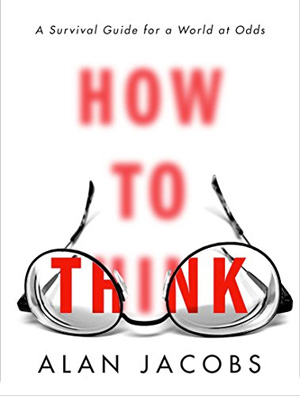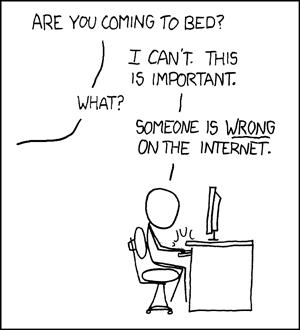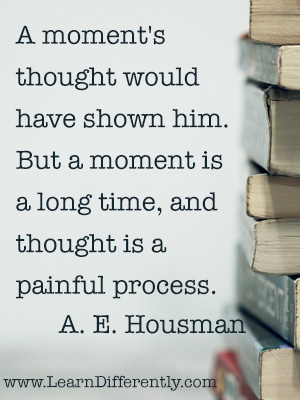Learning the Art of Thinking: Review of Alan Jacobs’ book, How to Think

by Kathy Kuhl How do you recommend a book called How to Think: A Survival Guide for A World at Odds, without insulting your readers? Author Alan Jacobs recommends saying, “I’m sure you know someone who could benefit from this book.” And I’m sure you do.
Why am I reviewing a book on thinking, for blog on struggling learners?
This may seem like an atypical topic for this blog, but Jacobs’ book is valuable for parents of struggling learners. Here’s why:
- All parents need to think carefully about what their children and teens need to learn, and how they learn. When parents homeschool, they have to think about goals and curriculum, and may face challenges from relatives and friends about how they homeschool. When the kids have learning challenges, parents need to think wisely about the challenges, therapies, and treatments.
- In an age of incivility, Alan Jacobs talks about how to respect those we disagree with. This is a challenge that parents of kids who learn differently will face often.
- Alan Jacobs is a good writer—clear, thoughtful, and drily humorous, never self-conscious or showy. There are so many good lines in this book that I am fighting the urge to turn this article into a list of fifty favorite quotations. The chapters read like essays, almost like conversations with a well-read, wise friend.
- It’s thought provoking and not at all dry. Jacobs teaches in the Honors Program at Baylor University, formerly at Wheaton College. He knows how to communicate in ways that keep weary freshmen awake.

- The book is short, around 150 pages. You have time for this. Even a few pages now and then will give you food for thought.
- Finally and most relevant for my readers, we all want our children to grow up to be thoughtful, useful citizens. We want to raise kids who are not swayed by the crowd but engage with the truth. We can equip them better as we improve our own thinking skills.
- Often we focus on teaching basic skills to our struggling learners, but what is more important than thinking? Just because your child struggles with spelling or math facts or handwriting, doesn’t mean they can’t think deeply.
- Struggling learners can also be gifted. Teaching them to think well is especially important and will help them make the most their potential.
What’s the flavor and goal of this book?
I can’t resist sharing some of the many quotations I copied out from the book, to give you a sense of its flavor. Jacobs quotes everyone from basketball great Wilt Chamberlain to Christian writer C.S. Lewis to philosopher John Stuart Mill, but my favorite lines are Jacobs’ own.

“We have thought too much in recent years about the science of thinking and not enough about the art.” (p. 16)
Our main problem is “an orientation of the will: we suffer from a settled determination to avoid thinking.” (p. 17)

In his introduction Jacobs argues that when we disagree strongly with others, often we stop trying to follow their reasoning. We stop listening. We become desperate to contradict. The flood of information and opinion we encounter on social media and the Internet deepens our tendency to react too quickly.
How should we (and our children) treat people who differ from us in our thinking and culture? If our acquaintances hold opposing views, why do we tend to see them as repugnant, rather than fellow humans? How can we learn to see our patterns of automatic thought, so we can treat others decently? Can we improve our ability to think, instead of react? Addressing these questions is the goal of the book.
Fundamentals of Thinking
Chapter 1, “Beginning to Think,” says that thinking is risky. Jacobs says that “There are no guarantees that it will make us happy or even give us satisfaction.” (p. 36) In addition, “Thinking is necessarily, thoroughly, and wonderfully social. Everything you think is a response to what someone else has thought and said.” (p. 37) Jacobs also explains why thinking must not be strictly rational. We must not suppress all feelings in order to think well.
In Chapter 2, “Attractions,” the author considers what draws us to some groups, how moral intuitions drive thinking, and the appeal of the “Inner Ring” versus the appeal of healthy communities. Jacobs also addresses being people of integrity in our disagreements, negotiating, and knowing what’s non-negotiable.
Chapter 3 turns to “Repulsions.” Wanting to punish the group we detest can be stronger than our desire to support our own group. What are the benefits of rule of law and civility? (Hint: don’t wait until your group is not in power to find out!)
Tools for Thinking
Chapter 4 discusses the power of words, the use of keywords, and how unacknowledged metaphors shape our thinking. It also covers how we dichotomize, and when to change the stories we use to interpret situations and life. Jacobs explains that instead of battling straw men (caricatures of our opponents), we need to find a “steel man”—a strong, clear opposing view. To argue with someone fruitfully, you need to be able to explain their arguments to their satisfaction. (Dr. David Coffin calls this Gerstner’s Law. See links at end of the post.)
Chapter 5 covers “The Age of Lumping,” or shoving people into categories. When should we form new categories?
In Chapter 6, “Open and Shut,” Jacobs asks: is an open mind always good? He discusses how to avoid being too rigid or too squishy in your thinking.
Chapter 7, “A Person, Thinking” ponders how to explain why some issues matter and your opinion is right, without sounding like a jerk. This requires rigor and humility. We also need to speak to others using appropriate vocabulary and style to communicate and to show respect. (This is the lesson for the child who is shunned on the playground for sounding like a adult, coming across as pretentious.)
The book concludes with “The Pleasures and Dangers of Thinking” and “The Thinking Person’s Checklist.”
How to Use this Book
How to Think is not a textbook, but a short work of nonfiction. It’s a book that repays rereading and note-taking. I suggest you read it, and then take it a few pages at a time with an older teen. It would be excellent to study before college or career.
My Recommendation
How to Think is the most thought-provoking book I’ve read in several years. So it worked for me. I’d like to buy you each a copy of this book, but I can’t. You, however, can buy it here.
If I haven’t convinced you to sample it yet, perhaps you would enjoy hearing the author. I decided to read How to Think this after hearing Carl Trueman, Todd Pruitt and Aimee Byrd interview Alan Jacobs on their Mortification of Spin podcast. You can listen here.
What do you think?
What has shaped how you think and engage in dialogue with those you disagree with? Please answer in the comment section below. Thank you.
Sources and resources
- A.E. Housman quotation from this page.
- “Twenty Principles of Effective Argumentation” by David F. Coffin. These concise rules by a friend and pastor are great tools to give any student in debate—or any teen or adult.
- XKCD comic,”Duty Calls,” courtesy https://xkcd.com/386/



Sounds like an interesting book worth picking up.